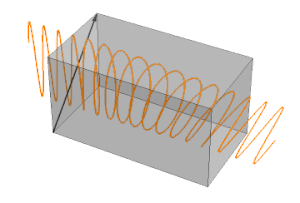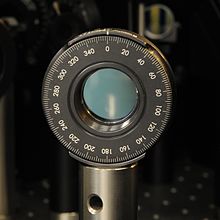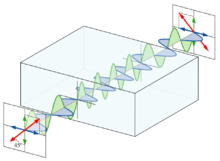Informatics Educational Institutions & Programs
Contents

A waveplate or retarder is an optical device that alters the polarization state of a light wave travelling through it. Two common types of waveplates are the half-wave plate, which rotates the polarization direction of linearly polarized light, and the quarter-wave plate, which converts between different elliptical polarizations (such as the special case of converting from linearly polarized light to circularly polarized light and vice versa.)[1]
Waveplates are constructed out of a birefringent material (such as quartz or mica, or even plastic), for which the index of refraction is different for light linearly polarized along one or the other of two certain perpendicular crystal axes. The behavior of a waveplate (that is, whether it is a half-wave plate, a quarter-wave plate, etc.) depends on the thickness of the crystal, the wavelength of light, and the variation of the index of refraction. By appropriate choice of the relationship between these parameters, it is possible to introduce a controlled phase shift between the two polarization components of a light wave, thereby altering its polarization.[1] With an engineered combination of two birefringent materials, an achromatic waveplate[2] can be manufactured such that the spectral response of its phase retardance can be nearly flat.
A common use of waveplates—particularly the sensitive-tint (full-wave) and quarter-wave plates—is in optical mineralogy. Addition of plates between the polarizers of a petrographic microscope makes the optical identification of minerals in thin sections of rocks easier,[3] in particular by allowing deduction of the shape and orientation of the optical indicatrices within the visible crystal sections. This alignment can allow discrimination between minerals which otherwise appear very similar in plane polarized and cross polarized light.
Principles of operation


A waveplate works by shifting the phase between two perpendicular polarization components of the light wave. A typical waveplate is simply a birefringent crystal with a carefully chosen orientation and thickness. The crystal is cut into a plate, with the orientation of the cut chosen so that the optic axis of the crystal is parallel to the surfaces of the plate. This results in two axes in the plane of the cut: the ordinary axis, with index of refraction no, and the extraordinary axis, with index of refraction ne. The ordinary axis is perpendicular to the optic axis. The extraordinary axis is parallel to the optic axis. For a light wave normally incident upon the plate, the polarization component along the ordinary axis travels through the crystal with a speed vo = c/no, while the polarization component along the extraordinary axis travels with a speed ve = c/ne. This leads to a phase difference between the two components as they exit the crystal. When ne < no, as in calcite, the extraordinary axis is called the fast axis and the ordinary axis is called the slow axis. For ne > no the situation is reversed.
Depending on the thickness of the crystal, light with polarization components along both axes will emerge in a different polarization state. The waveplate is characterized by the amount of relative phase, Γ, that it imparts on the two components, which is related to the birefringence Δn and the thickness L of the crystal by the formula
where λ0 is the vacuum wavelength of the light.
Waveplates in general, as well as polarizers, can be described using the Jones matrix formalism, which uses a vector to represent the polarization state of light and a matrix to represent the linear transformation of a waveplate or polarizer.
Although the birefringence Δn may vary slightly due to dispersion, this is negligible compared to the variation in phase difference according to the wavelength of the light due to the fixed path difference (λ0 in the denominator in the above equation). Waveplates are thus manufactured to work for a particular range of wavelengths. The phase variation can be minimized by stacking two waveplates that differ by a tiny amount in thickness back-to-back, with the slow axis of one along the fast axis of the other. With this configuration, the relative phase imparted can be, for the case of a quarter-wave plate, one-fourth a wavelength rather than three-fourths or one-fourth plus an integer. This is called a zero-order waveplate.
For a single waveplate changing the wavelength of the light introduces a linear error in the phase. Tilt of the waveplate enters via a factor of 1/cos θ (where θ is the angle of tilt) into the path length and thus only quadratically into the phase. For the extraordinary polarization the tilt also changes the refractive index to the ordinary via a factor of cos θ, so combined with the path length, the phase shift for the extraordinary light due to tilt is zero.
A polarization-independent phase shift of zero order needs a plate with thickness of one wavelength. For calcite the refractive index changes in the first decimal place, so that a true zero order plate is ten times as thick as one wavelength. For quartz and magnesium fluoride the refractive index changes in the second decimal place and true zero order plates are common for wavelengths above 1 μm.
Plate types
Half-wave plate

For a half-wave plate, the relationship between L, Δn, and λ0 is chosen so that the phase shift between polarization components is Γ = π. Now suppose a linearly polarized wave with polarization vector is incident on the crystal. Let θ denote the angle between and , where is the vector along the waveplate's fast axis. Let z denote the propagation axis of the wave. The electric field of the incident wave is
Quarter-wave plate


For a quarter-wave plate, the relationship between L, Δn, and λ0 is chosen so that the phase shift between polarization components is Γ = π/2. Now suppose a linearly polarized wave is incident on the crystal. This wave can be written as
where the f and s axes are the quarter-wave plate's fast and slow axes, respectively, the wave propagates along the z axis, and Ef and Es are real. The effect of the quarter-wave plate is to introduce a phase shift term eiΓ =eiπ/2 = i between the f and s components of the wave, so that upon exiting the crystal the wave is now given by
The wave is now elliptically polarized.
If the axis of polarization of the incident wave is chosen so that it makes a 45° with the fast and slow axes of the waveplate, then Ef = Es ≡ E, and the resulting wave upon exiting the waveplate is
and the wave is circularly polarized.
If the axis of polarization of the incident wave is chosen so that it makes a 0° with the fast or slow axes of the waveplate, then the polarization will not change, so remains linear. If the angle is in between 0° and 45° the resulting wave has an elliptical polarization.
A circulating polarization can be visualized as the sum of two linear polarizations with a phase difference of 90°. The output depends on the polarization of the input. Suppose polarization axes x and y parallel with the slow and fast axis of the waveplate:

The polarization of the incoming photon (or beam) can be resolved as two polarizations on the x and y axis. If the input polarization is parallel to the fast or slow axis, then there is no polarization of the other axis, so the output polarization is the same as the input (only the phase more or less delayed). If the input polarization is 45° to the fast and slow axis, the polarization on those axes are equal. But the phase of the output of the slow axis will be delayed 90° with the output of the fast axis. If not the amplitude but both sine values are displayed, then x and y combined will describe a circle. With other angles than 0° or 45° the values in fast and slow axis will differ and their resultant output will describe an ellipse.
Full-wave, or sensitive-tint plate
A full-wave plate introduces a phase difference of exactly one wavelength between the two polarization directions, for one wavelength of light. In optical mineralogy, it is common to use a full-wave plate designed for green light (a wavelength near 540 nm). Linearly polarized white light which passes through the plate becomes elliptically polarized, except for that green light wavelength, which will remain linear. If a linear polarizer oriented perpendicular to the original polarization is added, this green wavelength is fully extinguished but elements of the other colors remain. This means that under these conditions the plate will appear an intense shade of red-violet, sometimes known as "sensitive tint".[4] This gives rise to this plate's alternative names, the sensitive-tint plate or (less commonly) red-tint plate. These plates are widely used in mineralogy to aid in identification of minerals in thin sections of rocks.[3]
Multiple-order vs. zero-order waveplates
A multiple-order waveplate is made from a single birefringent crystal that produces an integer multiple of the rated retardance (for example, a multiple-order half-wave plate may have an absolute retardance of 37λ/2). By contrast, a zero-order waveplate produces exactly the specified retardance. This can be accomplished by combining two multiple-order wave plates such that the difference in their retardances yields the net (true) retardance of the waveplate. Zero-order waveplates are less sensitive to temperature and wavelength shifts, but are more expensive than multiple-order ones.[5]
Stacking a series of different-order waveplates with polarization filters between them yields a Lyot filter. Either the filters can be rotated, or the waveplates can be replaced with liquid crystal layers, to obtain a widely tunable pass band in optical transmission spectrum.
Use in mineralogy and optical petrology
The sensitive-tint (full-wave) and quarter-wave plates are widely used in the field of optical mineralogy. Addition of plates between the polarizers of a petrographic microscope makes easier the optical identification of minerals in thin sections of rocks,[3] in particular by allowing deduction of the shape and orientation of the optical indicatrices within the visible crystal sections.
In practical terms, the plate is inserted between the perpendicular polarizers at an angle of 45 degrees. This allows two different procedures to be carried out to investigate the mineral under the crosshairs of the microscope. Firstly, in ordinary cross polarized light, the plate can be used to distinguish the orientation of the optical indicatrix relative to crystal elongation – that is, whether the mineral is "length slow" or "length fast" – based on whether the visible interference colors increase or decrease by one order when the plate is added. Secondly, a slightly more complex procedure allows for a tint plate to be used in conjunction with interference figure techniques to allow measurement of the optic angle of the mineral. The optic angle (often notated as "2V") can both be diagnostic of mineral type, as well as in some cases revealing information about the variation of chemical composition within a single mineral type.
See also
- Crystal optics
- Fresnel rhomb
- Photoelastic modulator
- Polarization rotator
- Q-plate
- Spatial light modulator
- Zone plate
References
- ^ a b c Hecht, E. (2001). Optics (4th ed.). pp. 352–5. ISBN 0805385665.
- ^ "Mounted Achromatic Wave Plates". www.thorlabs.com. Retrieved 2024-01-16.
- ^ a b c Winchell, Newton Horace; Winchell, Alexander Newton (1922). Elements of Optical Mineralogy: Principles and Methods. Vol. 1. New York: John Wiley & Sons. p. 121.
- ^ "Tint plates". DoITPoMS. University of Cambridge. Retrieved Dec 31, 2016.
- ^ "Understanding Waveplates". www.edmundoptics.com. Edmund Optics. Retrieved 2019-05-03.
External links
- Waveplates RP photonics Encyclopedia of Laser Physics and Technology
- Polarizers and Waveplates Animation





















![{\displaystyle E(\cos \theta \,\mathbf {\hat {f}} -\sin \theta \,\mathbf {\hat {s}} )\mathrm {e} ^{i(kz-\omega t)}=E[\cos(-\theta )\mathbf {\hat {f}} +\sin(-\theta )\mathbf {\hat {s}} ]\mathrm {e} ^{i(kz-\omega t)}.}](https://wikimedia.org/api/rest_v1/media/math/render/svg/76320d33675c6848b39d4188acd7a36db1c791c6)







